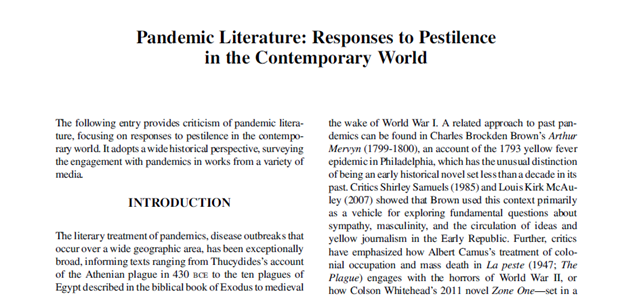| By Jennifer Stock, Sr. Content Developer |
As the COVID-19 pandemic spread across the world, many people looked to the past to try to make sense of how this disease has affected us and how our predecessors made it through similarly difficult times. In the earliest months of 2020, numerous media outlets ran stories about the Spanish flu pandemic of 1918–1919, drawing parallels to COVID-19.
Literature is another valuable resource as we seek an understanding of shared human experience throughout history. Several works from the ancient world feature plagues and epidemics. For example, Homer’s epic The Iliad (eighth century BCE) begins with a plague ravaging the Greek army camp at Troy, and the biblical book of Exodus describes the 10 plagues of Egypt. In both these works, disease is a divine punishment, but pandemic literature also addresses a wide range of other themes.
Contemporary Literary Criticism, Volume 483, publishing this month from Gale, a Cengage company, explores “Pandemic Literature: Responses to Pestilence in the Contemporary World,” with a focus on the many themes of the genre. The entry introduction notes that “pandemic literature frequently engages questions of history, witnessing, and testimony.” For example, Percival Hunt’s 1958 essay on London’s Great Plague of 1665 relies on the firsthand account of The Diary of Samuel Pepys (1660–1669) for details about the progression of the disease and its effect on daily life.
Social and political themes include questions of race, imperialism, and globalization, and these topics are often intertwined. Several critics have written about how eighteenth- and nineteenth-century Britons often conflated their fear of disease with their view of colonial cultures as potentially threatening to British societal norms. Discussing Bram Stoker’s Dracula (1897), Krystal Iseminger (2017) wrote: “The nature of disease and the fears related to infection can, through Stoker’s novel, be tied to the social and political concerns of the period, illustrating that the fear of infection in Dracula mirrors not only the fear of national degeneracy in late Victorian England, but the dread of invasion as well.” Indeed, Dracula comes to England from a foreign land, bringing the metaphorical disease of vampirism which, according to Jens Lohfert Jørgensen (2015), “disturbs the relationship between the individual and God by defying death.”
Zombiism is often treated by authors and filmmakers as a pandemic, and many critics writing about zombie stories have focused on the theme of capitalism. In a 2014 article, Sven Cvek analyzes Colson Whitehead’s Zone One (2011) in this light, noting that the novel was published shortly after the financial crisis of 2008. According to Cvek, “The zombie metaphor allows Whitehead to speak of the increasing economic and social insecurity of the American middle-class.” Mark Spitz, the protagonist, used to work in a white-collar position for a multinational company, but now works a low-level military job clearing the Zone One area of zombies to make it safe for others to inhabit. Spitz’s experience, Czek asserts, is representative of an increasing vulnerability of white-collar workers.
Pandemic texts also provide a means to process collective trauma. As new epidemics emerge, there’s often a resurgence of interest in pandemic literature. When plague appeared in France in 1722, Daniel Defoe’s A Journal of the Plague Year, a novel set during London’s 1665 plague, was rushed to the printer. It remains to be seen how today’s authors will address COVID-19, but until those works are published, there’s a large amount of pandemic literature to which we can turn.
Contemporary Literary Criticism, Volume 483, is available July 2021 in print and online via Gale Literature Criticism. The volume also includes a list of representative works in the genre and primary source excerpts from pandemic texts.
For further exploration of pandemic literature, check out this post written by a third-year student!
Meet the Author
Jennifer Stock is a senior content developer at Gale, a Cengage Company, where she has worked on a variety of projects, including eBooks and electronic databases, for K‒12 and academic audiences.


